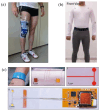Leveraging Machine Learning for Personalized Wearable Biomedical Devices: A Review
- PMID: 38392636
- PMCID: PMC10890129
- DOI: 10.3390/jpm14020203
Leveraging Machine Learning for Personalized Wearable Biomedical Devices: A Review
Abstract
This review investigates the convergence of artificial intelligence (AI) and personalized health monitoring through wearable devices, classifying them into three distinct categories: bio-electrical, bio-impedance and electro-chemical, and electro-mechanical. Wearable devices have emerged as promising tools for personalized health monitoring, utilizing machine learning to distill meaningful insights from the expansive datasets they capture. Within the bio-electrical category, these devices employ biosignal data, such as electrocardiograms (ECGs), electromyograms (EMGs), electroencephalograms (EEGs), etc., to monitor and assess health. The bio-impedance and electro-chemical category focuses on devices measuring physiological signals, including glucose levels and electrolytes, offering a holistic understanding of the wearer's physiological state. Lastly, the electro-mechanical category encompasses devices designed to capture motion and physical activity data, providing valuable insights into an individual's physical activity and behavior. This review critically evaluates the integration of machine learning algorithms within these wearable devices, illuminating their potential to revolutionize healthcare. Emphasizing early detection, timely intervention, and the provision of personalized lifestyle recommendations, the paper outlines how the amalgamation of advanced machine learning techniques with wearable devices can pave the way for more effective and individualized healthcare solutions. The exploration of this intersection promises a paradigm shift, heralding a new era in healthcare innovation and personalized well-being.
Keywords: machine learning; personalized; wearable devices.
Conflict of interest statement
The authors declare no conflict of interest.
Figures





References
-
- Ravenscroft D., Prattis I., Kandukuri T., Samad Y.A., Occhipinti L.G. A Wearable Graphene Strain Gauge Sensor with Haptic Feedback for Silent Communications; Proceedings of the 2021 IEEE International Conference on Flexible and Printable Sensors and Systems (FLEPS); Manchester, UK. 20–23 June 2021; pp. 1–4.
-
- Wang S., Liu B., Wang Y.-L., Hu Y., Liu J., He X.-D., Yuan J., Wu Q. Machine-Learning-Based Human Motion Recognition via Wearable Plastic-Fiber Sensing System. IEEE Internet Things J. 2023;10:17893–17904. doi: 10.1109/JIOT.2023.3277829. - DOI
-
- Annabestani M., Esmaeili-Dokht P., Nejad S.K., Fardmanesh M. NAFAS: Non-Rigid Air Flow Active Sensor, a Cost-Effective, Wearable, and Ubiquitous Respiratory Bio-Sensor. IEEE Sens. J. 2021;21:9530–9537. doi: 10.1109/JSEN.2021.3053211. - DOI
-
- Islam M.M., Manjur S.M. Design and Implementation of a Wearable System for Non-Invasive Glucose Level Monitoring; Proceedings of the 2019 IEEE International Conference on Biomedical Engineering, Computer and Information Technology for Health (BECITHCON); Dhaka, Bangladesh. 28–30 November 2019; pp. 29–32.
Publication types
LinkOut - more resources
Full Text Sources

